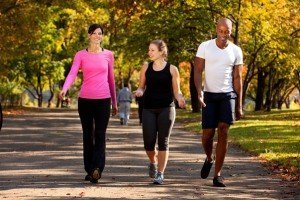 There are almost as many reasons to walk as there are people who walk. People walk for pleasure, to stay in shape or manage their weight. The more you walk, the more reasons you’ll find to make walking part of your daily routine.
There are almost as many reasons to walk as there are people who walk. People walk for pleasure, to stay in shape or manage their weight. The more you walk, the more reasons you’ll find to make walking part of your daily routine.
Step it up
It’s easy to take the first step and to increase the number of steps you take each day.
- Walk partway or all the way home from work or school.
- Walk to the store or on other errands.
- Walk the stairs, instead of using an elevator or escalator.
- Walk a block at break time or lunch.
- Walk a dog (borrow your neighbour’s if you don’t have one)
- Answer the phone farthest away; at work, use the photocopier on another floor.
Benefits of Walking
- Walking refreshes the mind, reduces fatigue and increases energy.
- More than half the body’s muscles are designed for walking; it is natural movement that is virtually injury-free.
- Walking provides an enjoyable time for sharing and socializing with friends or family.
- Regular, brisk walking can reduce elevated blood fats or blood pressure and improve digestion and elimination.
- Walking strengthens bones and helps prevent or control osteoporosis (a condition where bones become brittle and fragile).
- Walking relieves stress and tension.
- Regular walking will help you maintain a healthy weight and a positive body image, especially when combined with healthy eating.
- Brisk Walking trains your heart, lungs and muscles to work more efficiently.
Stepping Out
In planning your walking program consider the following tips:
- A little walking everyday is far better than an occasional weekend bout of frenzied activity. Aim to make brisk short walks a daily even (at least 15 minutes), with longer walks (45 to 60 minutes) every second day.
- Explore a variety of routes and choose ones that are interesting, safe and convenient. Avoid heavy traffic, loose dogs and rough terrain.
- Walking with others can be more motivating than walking alone.
- Walk Safely. Don’t wear headphones in downtown traffic. At night, walk with a friend and wear reflective tape on your clothing. Carry identification and a cell phone.
- On summer evenings or in the woods, protect yourself from insect bites by wearing long sleeves and mosquito repellant.
- When it is hot, choose a shaded route and walk a little slower than usual. Avoid the hot noonday sun. Wear a hat and sunscreen.
- When it is cold, avoid icy surfaces. Walk at a local shopping centre in cold weather.
- Dress in loose, comfortable clothing made of soft fabrics.
Getting Started
Warm up and cool down with 5 minutes of medium-paced walking, followed by some stretches for your legs. This will prevent stiffness and increase your flexibility.
- Calf muscles stretch: Stand facing a wall. Position your forward foot approximately 30-40cm from the wall. Stretch your arms forward, elbows straight and lean against the wall. Place your other foot a few inches behind the front foot and slowly paint it flat on the floor. Lean forward until you feel a stretch in your back leg. Hold for 15-30 seconds. Relax and repeat 2 times with alternate legs.
- Hamstring muscles stretch: Sitting on the floor, put one leg straight out and the other leg bent at the knee. Keeping your back straight, lean forward, sliding your hands down the straight leg until you feel a stretch. Hold for 15-30 seconds. Relax and repeat 2 more times with alternate legs.
- Thigh Stretch sitting:Sit on the edge of a chair. Lower your knee toward the floor and press it back under the chair. Hold the stretch for 15-20 seconds. Repeat each leg 2 times.
- Alternate thigh muscles stretch: Stand close to a wall and place one hand on it. With the other hand reach back and hold the same side foot in that hand. When balanced, begin to slowly raise the foot up towards the lower back. Hold for 15-30 seconds. Relax and repeat 2 more times with alternate legs.
- Achilles Stretch: Sitting on a chair, plant one heel on the floor and gently lift your toes up and back as far as you can. Hold for a count of 5 and then relax. Repeat each foot several times.
Walking Shoes
When you walk, your feet hit the ground more than 650 times each km, so comfortable socks and well-designed walking or jogging shoes are a must. Shop for walking shoes at the end of the day, when you feet are larger. Try on both shoes and walk around in the store before buying them.
Count your Steps to Better Health:
How many steps do you take in a day? Most people would have difficulty answering this question. The average sedentary person accumulates about 3500-5000 steps during the course of their day. In general, to improve your health a person should add 2000-3000 more steps to their day than they get from their general activities.
If your total number of steps per day is:
- Under 5,000 you would b considered as having a sedentary lifestyle.
- Between 5,000-7,499 you would be considered as “low active”.
- Between 7,500 – 9,999 this would indicate you are getting some exercise or walking and would be considered “somewhat active”.
- More than 10,000 steps indicate that you would be considered an “active”
- More than 12,500 steps/day would classify you as being “highly active”.
You can accumulate steps throughout the day. It only takes about 5 minutes to get in 500 steps, so doing simple things like parking farther away from a store entrance increases your daily count. Combining this with continuous walking will improve your health and fitness, and help you maintain a healthy weight.
It’s as easy as one, two three
If you would like to try step counting, follow these guidelines:
1.Choose your Pedometer and Test it out
A Pedometer is a small battery-powered device that displays on a screen the number of steps you take. They are sold in many sporting goods and department stores. Clip your pedometer onto your waistband or belt. It should be snug on your hip and lined up above your knee. Set the counter to Zero and walk 20 steps. Check to see that it accurately records the number of steps.
If you don’t have a pedometer make a commitment to walk a minimum of 30 minutes every day.
2.Set your Daily Step Goal
Recommended daily step goals depend on your age and current level of physical activity. They also depend on how active you want to be. The best way to get there is to gradually increase the number of steps you take each day.
3.Keep a weekly walking log
Use it to record your baseline and your progress over the weeks ahead.
Increasing the Intensity of your Walk
Here are four ways to further increase the intensity of your walking program.
Speed Walking:
Breathe normally and pump your arms vigorously as you speed up your pace. Practice over short distances until you can walk comfortably at the vigorous pace of 7 to 9 km per hour.
Climb Walking:
Climbing hills or stairs is the most vigorous form of walking. Climbing put extra strain on the stomach, buttocks, lower back and leg muscles, so add some exercises for these muscles and additional stretches to your warm-up. Increase your hill work gradually.
Water Walking:
Walking in the water increase the difficulty because you move against the resistance of the water. Water walking is easy on the joints and refreshingly cool in hot weather.
Holiday Walking:
Enjoy a walking on a holiday.
 Optical Network
Optical Network






